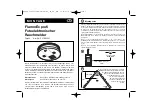
25
Chapter 3 Calibration
The PhD Ultra multi-gas detector has been designed
for easy calibration. A single control, the on/off
mode button, is used to initiate the automatic
calibration sequence and to automatically make
calibration adjustments.
It is also possible to manually calibrate the
instrument by using the four pushbuttons located on
the instrument keypad.
“One-Button Auto-Calibration” procedures are
discussed in Section 3.4. Manual calibration
procedures are discussed in Section 3.5.
3.1
Verification of accuracy
Accuracy of the PhD Ultra
should be checked periodically with known
concentration calibration gas. Failure to check
accuracy can lead to inaccurate and potentially
dangerous readings.
Always check the expiration
date on calibration gas cylinder(s) prior to use.
Expired calibration gas can lead to inaccurate
and potentially dangerous readings.
Verification of accuracy is a two step procedure. In
the first step the PhD Ultra is taken to an area where
the atmosphere is fresh and the readings are
checked. If the readings differ from those expected
in fresh air, a "zero" adjustment must be made.
Step two is to make sure the sensors are accurate
by exposing them to a test gas of known
concentration and noting the sensor response.
Oxygen readings are considered to be accurate
when the display is within ±0.5% of the expected
concentration as given on the calibration gas
cylinder. LEL and toxic readings are considered
accurate when they are between 90% and 120% of
the expected value as given on the calibration gas
cylinder. (CSA requires the reading to fall between
100% and 120% to be considered accurate). If
readings are accurate, there is no need to adjust
your gas detector. If the readings are inaccurate,
the instrument must be span calibrated before
further use.
Biosystems offers calibration kits and long lasting
cylinders of test gas specifically developed for easy
PhD Ultra calibration.
Use of non-standard
calibration gas and/or calibration kit
components when calibrating the PhD Ultra can
lead to inaccurate and potentially dangerous
readings, and may void the standard
Biosystems warranty.
Customers are strongly urged to use only
Biosystems calibration materials when
calibrating the PhD Ultra.
3.1.1 Effect of contaminants on PhD Ultra
sensors
The atmosphere in which the PhD Ultra monitor is
being used can have an effect on the sensors.
Sensors may be poisoned or suffer degraded
performance if exposed to certain substances.
There are three basic types of sensors that may be
installed in the PhD Ultra detector: oxygen,
combustible gas (LEL), and electrochemical toxic.
Each type of sensor uses a slightly different
detection principle so the conditions that affect the
accuracy of the sensors vary from one type of
sensor to the next.
The accuracy of the PhD Ultra
sensors should be checked immediately
following any known exposure to contaminants
by testing with known concentration test gas
before further use.
3.1.1.1 Effects of contaminants on oxygen
sensors
Oxygen sensors may be affected by prolonged
exposure to "acid" gases such as carbon dioxide.
The oxygen sensors used in Biosystems instruments
are not recommended for continuous use in
atmospheres which contain more than 25% CO
2
.
3.1.1.2 Effects of contaminants on combustible
sensors
Combustible sensors may be affected by exposure
to substances containing silicone (found in many
lubricants and hydraulic fluids), the tetra-ethyl-lead
in "leaded" gasoline, and halogenated hydrocarbons
(Freons, or solvents such as trichloroethylene and
methylene chloride). High concentrations of
hydrogen sulfide may also damage the sensor.
Note: See the Biosystems Standard Warranty in
Appendix G for a more extensive list of LEL
sensor contaminants.
Note: If the combustible sensor suffers a loss of
sensitivity, it tends to be lost first with regards
to methane.
A partially poisoned sensor might still respond
accurately to propane while showing a dangerously
reduced response to methane.
Biosystems’ “Propane Equivalent” calibration gas
mixtures have been developed to eliminate this
potentially dangerous source of calibration error.
Biosystems’ “Propane Equivalent” mixtures are
based on methane, so any loss of sensitivity to
methane is detected (and can be corrected)
immediately.
















































